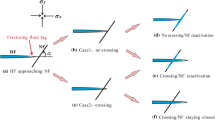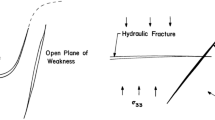Abstract
The interaction between HF (hydrofractures) and NF (natural fractures) is a complex-coupled process which involves several physical parameters. Despite numerous previous works, the respective role of in situ stress, natural fracture properties, and orientations is still difficult to assess. In this chapter, a fully hydromechanical coupled numerical model has been used to simulate different three-dimensional configurations. These configurations provide insight into how a natural fracture is mechanically or hydraulically activated depending on well-defined parameters. It has been shown that the natural fracture can be either activated hydraulically without any shear displacement or mechanically activated while not loaded hydraulically. These configurations are controlled at a first-order level by the combination of the in situ differential stress state and the natural fracture orientation.
Access this chapter
Tax calculation will be finalised at checkout
Purchases are for personal use only
Similar content being viewed by others
References
Britt, L. (2012). Fracture stimulation fundamentals. Journal of Natural Gas Science and Engineering, 8, 34–51.
Gale, J. F., Reed, R. M., & Holder, J. (2007). Natural fractures in the Barnett Shale and their importance for hydraulic fracture treatments. AAPG Bulletin, 91(4), 603–622.
Rogers, S., Elmo, D., Dunphy, R., & Bearinger, D. (2010, January). Understanding hydraulic fracture geometry and interactions in the Horn River Basin through DFN and numerical modeling. In Canadian Unconventional Resources and International Petroleum Conference. Society of Petroleum Engineers.
Liang, F., Sayed, M., Ghaithan, A.-M., Chang, F. F., & Li, L. (2016). A comprehensive review on proppant technologies. Petroleum, ISSN 2405-6561.
Jeffrey, R. G., Chen, Z. R., Zhang, X., Bunger, A. P., & Mills, K. W. (2015). Measurement and Analysis of Full-Scale Hydraulic Fracture Initiation and Reorientation. Rock Mechanics and Rock Engineering, 48(6), 2497–2512.
Olson, J. E., & Taleghani, A. D. (2009, January). Modeling simultaneous growth of multiple hydraulic fractures and their interaction with natural fractures. In SPE Hydraulic Fracturing Technology Conference. Society of Petroleum Engineers.
Neuzil, C. E. (2003). Hydromechanical coupling in geologic processes. Hydrogeology Journal, 11(1), 41–83.
Nagel, N. B., & Zhang, F. (2013). Coupled Numerical Evaluation of the Geomechanical Interactions between a Hydraulic Fracture Stimulation and a Natural Fracture System in Shale Formation. Rock Mech Rock Eng, Springer.
Papachristos, E., Scholtès L., Donzé, F. V., Chareyre, B., & Pourpak, H. (2015). Hydraulic fracturation simulated by a 3D coupled HM-DEM model, 13th International Symposium on Rock Mechanics, ISRM Congress.
Riahi, A., & Damjanac, B. (2013, May). Numerical study of interaction between hydraulic fracture and discrete fracture network. In ISRM International Conference for Effective and Sustainable Hydraulic Fracturing. International Society for Rock Mechanics.
Kovalyshen, Y., & Detournay, E. (2010). A reexamination of the classical PKN model of hydraulic fracture. Transport in Porous Media, 81(2), 317–339.
Perkins, T. K., & Kern, L. R. (1961). Width of hydraulic fractures. Texas: Journal of Petroleum Technology.
Cundall, P. A., & Strack, O. D. L. (1979). Geotechnique 29, No. 1, 47–65.
Donzé, F. V., Richefeu, V., & Magnier, S. A. (2009). Advances in discrete element method applied to soil, rock and concrete mechanics. State of the art of geotechnical engineering. Electronic Journal of Geotechnical Engineering, 44, 31.
Shi, G. H. (1992). Discontinuous deformation analysis: a new numerical model for the statics and dynamics of deformable block structures. Engineering Computations, 9(2), 157–168.
Itasca. (2013). 3DEC, Three Dimensional Distinct Element Code. Version 5.0, Minneapolis.
Kozicki, J., & Donzé, F. V. (2009). Yade-open dem: An open-source software using a discrete element method to simulate granular material. Engineering Computations, 26(7), 786–805.
Kozicki, J., & Donzé, F. V. (2008). A new open-source software developed for numerical simulations using discrete modeling methods. Computer Methods in Applied Mechanics and Engineering, 197(49), 4429–4443.
Abbas, S., & Lecampion, B. (2013, May). Initiation and breakdown of an axisymmetric hydraulicfracture transverse to a horizontal wellbore. In ISRM International Conference for Effective and Sustainable Hydraulic Fracturing. International Society for Rock Mechanics.
Yew, C. H. (1997). Mechanics of hydraulic fracturing. Amsterdam: Elsevier Science Ltd.
Fisher, N. I. (1996). Statistical analysis of circular data. Cambridge: Cambridge University Press.
Cipolla, C. L., Lolon, E. P., Erdle, J. C., & Rubin, B. (2010). Reservoir modeling in shale-gas reservoirs. SPE Reservoir Evaluation & Engineering, 13(04), 638–653.
Damjanac, B., & Cundall, P. (2016). Application of distinct element methods to simulation of hydraulic fracturing in naturally fractured reservoirs. Computers and Geotechnics, 71, 283–294.
Yaghoubi A., & Zoback M., (2012). Hydraulic fracturing modeling using a discrete fracture network in the Barnett Shale. Stanford Stress and Geomechanics Group. American Geophysical Union, Fall Meeting 2012.
Fu, P., Johnson, S. M., & Carrigan, C. R. (2013). An explicitly coupled hydro‐geomechanical model for simulating hydraulic fracturing in arbitrary discrete fracture networks. International Journal for Numerical and Analytical Methods in Geomechanics, 37(14), 2278–2300.
Grasselli, G., Lisjak, A., Mahabadi, O. K., & Tatone, B. S. (2015). Influence of pre-existing discontinuities and bedding planes on hydraulic fracturing initiation. European Journal of Environmental and Civil Engineering, 19(5), 580–597.
Khoei, A. R., Vahab, M., & Hirmand, M. (2015). Modeling the interaction between fluid-driven fracture and natural fault using an enriched-FEM technique. International Journal of Fracture, 197, 1–24.
Rahman, M. M. (2009, January). A fully coupled numerical poroelastic model to investigate interaction between induced hydraulic fracture and pre existing natural fracture in a naturally fractured reservoir: potential application in tight gas and geothermal reservoirs. In SPE Annual Technical Conference and Exhibition. Society of Petroleum Engineers.
Shah, R.K., and D.P. Sekulic. 2003. Fundamentals of heat exchanger design. New York: John Wiley & Son Publisher.
Hesselgreaves, J.E. 2007. Compact heat exchangers: Selection, design and operation. 3rd edition. Pergamon.
Acknowledgment
This work is supported by TOTAL SA.
Author information
Authors and Affiliations
Corresponding author
Editor information
Editors and Affiliations
Rights and permissions
Copyright information
© 2016 Springer International Publishing Switzerland
About this chapter
Cite this chapter
Rorato, R., Donzé, FV., Tsopela, A., Pourpak, H., Onaisi, A. (2016). Discrete Element Modeling of the Role of In Situ Stress on the Interactions Between Hydraulic and Natural Fractures. In: Jin, C., Cusatis, G. (eds) New Frontiers in Oil and Gas Exploration. Springer, Cham. https://doi.org/10.1007/978-3-319-40124-9_3
Download citation
DOI: https://doi.org/10.1007/978-3-319-40124-9_3
Published:
Publisher Name: Springer, Cham
Print ISBN: 978-3-319-40122-5
Online ISBN: 978-3-319-40124-9
eBook Packages: EnergyEnergy (R0)




